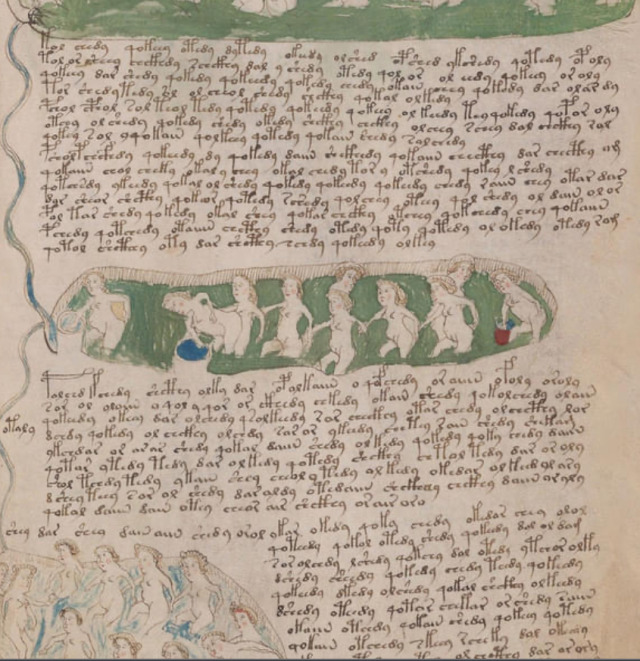I have spent some thoughts on the Voynich Manuscript (VMS) which I wish to share with you.
I think I need not tell you what the VMS is, should you have not heard of it yet, see Wikipedia.
Nobody has managed to decipher it yet. The many illustrations in the VMS give a hint at the content matter, which seems to encompass such things as astrology, medicine and herb-lore. Thus, it appears to be a kind of repository of hermetic knowledge, and the obscurity is deliberate: it is written the way it is to prevent the uninitiated from reading it.
The VMS has been C14-dated to the early 15th century, and there are reasons to assume that it was made in northern Italy. The writing system is clearly an alphabet, with 36 letters, of which 11 are variants of other letters with a horizontal stroke added. The alphabet looks like a close relative or derivation of the Latin alphabet.
There is a commonly used transliteration, the "European (or Extensible) Voynich Alphabet" (EVA), based on the letter shapes. This mostly gives quite pronounceable readings of the VMS text, so it is likely that it guessed at least the basic sound categories such as vowels, sonorants and obstruents, correctly. If there is a kind of letter substitution cipher involved, it seems to preserve those categories. But it may be that there is no such thing, and the EVA is actually close to the intended pronunciation. The following letters are the ones to which horizontal strokes are sometimes added: a, e, i, o, y, and p, t, k, f, s, h. So the horizontal stroke is added either to vowels or to voiceless obstruents. Perhaps this is a kind of length marker, and in the unknown language of the VMS, only voiceless obstruents may be geminated.
So what about the language? It is obviously unknown. The idea that it is an obscure natural language, such as a pre-Roman, perhaps even pre-IE, language surviving somewhere in the Alps cannot be ruled out, but more likely, we are dealing with an invented language. It is not impossible that someone made up a language in 15th-century Italy; other early conlangs such as Hildegard of Bingen's Lingua Ignota, John Dee's Enochian or the Near Eastern Balaybalan come to one's mind here.
A note on the Voynich Manuscript
- WeepingElf
- Posts: 1324
- Joined: Sun Jul 15, 2018 12:39 pm
- Location: Braunschweig, Germany
- Contact:
A note on the Voynich Manuscript
... brought to you by the Weeping Elf
My conlang pages
My conlang pages
Re: A note on the Voynich Manuscript
(Side note: the lack of a font tag on this forum is a little vexing. I can neither use a "Voynichese" font nor represent "Voynichese" in monospace.)
The text of Beinecke MS 408 has some peculiar features, if it does represent some language (constructed or not) in plaintext. It makes heavy use of repetition: of individual "letters", such as the common family of words dain, daiin, daiiin; of sequences such as the four ors in a row on f15v, featuring a space moved one "letter" to the left perhaps to break up the repetition; of entire words up to three times, such as the Sheol Sheol Sheol on f104v. There is almost certainly more structure to the "Voynichese alphabet" than is captured by the standard transcription system; a may be a combined e and i, for example, and sequences like n, in, iin, iiin; r, ir, iir, iiir; m, im, iim, iiim have some of the character of being unitary graphemes.
The text of Beinecke MS 408 has some peculiar features, if it does represent some language (constructed or not) in plaintext. It makes heavy use of repetition: of individual "letters", such as the common family of words dain, daiin, daiiin; of sequences such as the four ors in a row on f15v, featuring a space moved one "letter" to the left perhaps to break up the repetition; of entire words up to three times, such as the Sheol Sheol Sheol on f104v. There is almost certainly more structure to the "Voynichese alphabet" than is captured by the standard transcription system; a may be a combined e and i, for example, and sequences like n, in, iin, iiin; r, ir, iir, iiir; m, im, iim, iiim have some of the character of being unitary graphemes.
- Man in Space
- Posts: 1521
- Joined: Sat Jul 21, 2018 1:05 am
Re: A note on the Voynich Manuscript
The possibilities of it being someone's shorthand writing, possibly a personal one, was raised at least twenty years ago but -- apparently? -- hasn't gone anywhere. All these 'peculiar features' certainly remind me of what (very little) I've read about Greek- and Latin-script shorthands and even more of what I had to learn of Tibetan one(s).Ketsuban wrote: ↑Sun Feb 25, 2024 9:09 am The text of Beinecke MS 408 has some peculiar features, if it does represent some language (constructed or not) in plaintext. It makes heavy use of repetition: of individual "letters", such as the common family of words dain, daiin, daiiin; of sequences such as the four ors in a row on f15v, featuring a space moved one "letter" to the left perhaps to break up the repetition; of entire words up to three times, such as the Sheol Sheol Sheol on f104v. There is almost certainly more structure to the "Voynichese alphabet" than is captured by the standard transcription system; a may be a combined e and i, for example, and sequences like n, in, iin, iiin; r, ir, iir, iiir; m, im, iim, iiim have some of the character of being unitary graphemes.
I do remember people on the old (Web 1.0) Voynich discussion groups getting pretty angry about the whole idea, though. (Though, also, it was a testy scene at best.)


